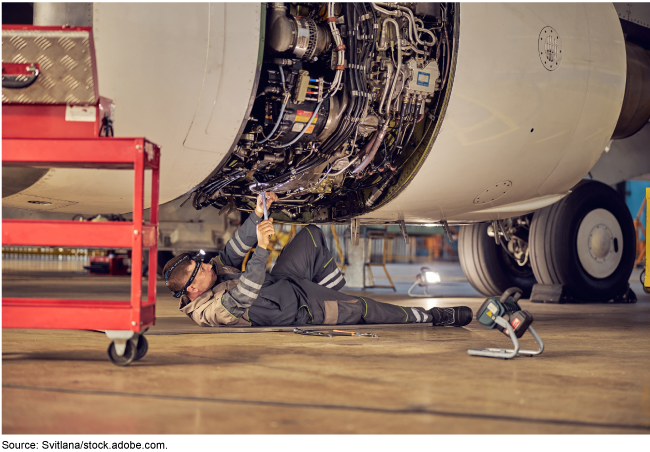Aviation Workforce: Supply of Airline Pilots and Aircraft Mechanics
Fast Facts
This testimony discusses our ongoing review of the workforce challenges facing commercial aviation and steps the industry is taking to address them.
Increased demand for commercial airline travel heightens the need for pilots and mechanics. Although the number of pilots has grown in recent years, there may not be enough of them to meet the needs of airlines in the future. There also may not be enough mechanics to reduce a backlog in airplane repairs.
To make aviation careers more attractive, airlines and maintenance facilities are offering higher pay to these workers. Airlines are also creating flight schools to train more pilots.

Highlights
What GAO Found
In ongoing work, GAO determined that the current supply of pilots—as measured by the number of individuals qualified to be U.S. passenger airline pilots—grew from 2017 through 2022. Enrollments in U.S. pilot training schools also increased in recent years. Pilot supply may increase over the next two decades, according to Federal Aviation Administration (FAA) pilot certification data and forecasts. However, the extent to which projected supply would exceed or fall short of industry's demand for pilots is unknown given uncertainties surrounding future demand. Publicly available data on hiring, employment, and wages indicate strong current demand for pilots. Meeting that demand has been particularly difficult for regional airlines—which generally serve smaller communities—and has, according to them, affected their operations.
Distribution of Active Airline Transport Pilot Certificates in 2022 by Age Group

Note: Pilots age 65 and over are no longer eligible for employment with scheduled U.S. passenger airlines, but could work as pilots or instructors elsewhere.
The number of people newly certificated by FAA to be aircraft mechanics grew from 2017 through 2022. Less is known about how many mechanics enter or exit the aviation industry each year or the demand for aircraft mechanics. However, aviation businesses GAO interviewed reported challenges maintaining sufficient numbers of mechanics.
Aviation industry stakeholders have taken steps to address workforce supply challenges. Airlines and repair stations are increasing pay for pilots and mechanics. For example, several regional airlines raised pay substantially in 2022. FAA is also undertaking efforts to support industry workforce development, including awarding grants to attract young people to aviation careers.
Why GAO Did This Study
The aviation industry has raised questions about whether the demand for commercial airline pilots and aircraft mechanics may exceed supply in the future. Industry's demand for pilots and mechanics is driven by a number of factors. These factors include projected demand for air travel and the number of aircraft that airlines expect to use to fulfill that demand, as well as anticipated workforce attrition and retirements.
This testimony highlights: (1) what is known about the current supply of and demand for commercial airline pilots and aircraft mechanics; (2) challenges related to aviation workforce supply, according to industry stakeholders; and (3) actions the aviation industry and FAA have taken to address those challenges.
This statement is based on GAO's body of published work on aviation workforce issues, including a draft report currently with the Department of Transportation and FAA for comment. For the draft report, GAO examined industry and government data on airline pilot and aircraft mechanics, including professional certifications, student enrollments, and hiring, wage, and employment data. GAO also interviewed representatives from domestic passenger and regional airlines; repair stations; faculty from training schools; and aviation industry and labor groups.
For more information, contact Heather Krause at (202) 512-2834 or krauseh@gao.gov.
